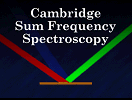|
|
|
Navigation Links |
||
| Home Page |
||
| Latest News |
||
| Group Members |
||
| Research Interests |
||
| Collaborations |
||
| Publications |
||
| Conferences |
||
| Contact Details |
||
| Gallery |
||
| Links |
||
Research InterestsFlash Pyrolysis Jet Spectroscopy
|

|
|
Summary of Interests |
|
The primary objective of this work is to study the rotationally resolved infrared spectra of Transition Metal Radicals. Our interest focuses on unsaturated metal carbonyl radicals and their complexes. Supersonic Jet cooling is used to simplify the complicated spectra of these radicals. The radicals themselves are generated using a flash pyrolysis method, an effective technique to generate high radical yields. Temperatures up to 1500 Kelvin can be applied to the heating nozzle where the metal carbonyls decompose into reactive fragments. Sensitive, high-resolution infrared diode laser spectroscopy is used to record the resulting spectra. The results of the work carried out here have key areas in two industrial applications: Chemical Vapour Deposition and Catalysis work. Chemical Vapour Deposition (CVD) is a widely-employed technique for the formation of thin metal and metal-containing films with applications in microelectronics, optoelectronics, protective coatings and optical coatings. We will be studying the intermediates in the CVD processes so that the mechanisms can be more clearly understood. We will also be studying the gas phase analogues of complexes directly involved in catalytic cycles, and thereby elucidating the bonding modes between transition metals and their ligands.  |
|
| Return to Top of Page | |